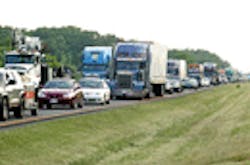Despite retaining the 11-hour dailydriving limit, many trucking and business organizations openly frowned on the hours-of-service(HOS) regulatory overhaul unveiled by the Federal Motor Carrier Safety Administration (FMCSA) yesterday. And though safety and labor groups are withholding commenton the finalrules for now – slated to go into effect in July 2013 – itis expected they will also react negatively, as they sought to reduce the dailydriving to 10 hours.
“Scrooge himself would gladly take second chair to the lack ofChristmas spirit displayed today by federal regulators that issuedunnecessarily restrictive rules on our nation’s truckers,” said MichaelCampbell, executive vp and CEO for the CaliforniaTrucking Assn. “The only gift these rules present is the one laid at thedoorstep anti-trucking groups.”
“Collectively, the changes in this [HOS] rule will have a dramaticeffect on the lives and livelihoods of small-business truckers,” said ToddSpencer executive vp for the Owner-OperatorIndependent Drivers Assn. (OOIDA). “The changes are unnecessary andunwelcome and will result in no significant safety gains.”
In particular, Bill Graves, president & CEO of the American Trucking Assns. (ATA),pointed to the “two rest period” mandate for drivers between 1 a.m. and 5 a.m.as part of the 34-hour “restart” provision as a serious problem.
That requirement “will create additional and unnecessarycongestion and put motorists and those professional drivers at greater risk,”he said. “The largest percentage of truck-involved crashes occurs between 6a.m. and noon, so this change not only effectively destroys the provision ofthe current rule most cited by professional drivers as beneficial, but it willput more trucks on the road during the statistically riskiest time of the day.”
The National Retail Federation tradeassociation, which represents retailers and chain restaurants, also believesthe two-break change to the restart provision is a troublesome issue.
“We’re pleased that regulators have seen the wisdom of keeping thecurrent11-hour limit, but longer overnight breaks create the potential for more bigtrucks to be mixing with passenger cars during congested daylight hours,” said DavidFrench, NRF’s senior vp for government relations.
“These new regulations will still drive up costs for businessesand consumers while making our highways and city streets more dangerous ratherthan safer,” he added. “This is a case where something that might sound good onpaper doesn’t work in the real world.”
The InternationalBrotherhood of Teamsters, long opposed to the 11-hour drive time limit,are in the words of their General President James Hoffa,“reviewing the new rule, and in the coming weeks we will meet and discuss itwith our allies and, if necessary, determine our next course of action.”
However, many believe that as the 11 hour drive-time limit wasleft in place, the Teamsters and others will no doubt file lawsuits against thenew HOSregulations.
“Groups that have historically been critical of the current HOS ruleswon’t be happy since they will have once again failed to obtain an unjustifiedreduction in allowable daily driving time,” said DanEngland, ATA’s chairman and chairman of refrigerated TL carrier C.R. England. “By forcing through these changesFMCSA has created a situation that will ultimately please no one … [while] boththe trucking industry and consumers will suffer the impact of reduced productivityand higher costs.”
Still, others noted that it’s a positive development that theagency retained the 11-hour limit, although FMCSA itself stressed that it will“continue to conduct data analysis and research tofurther examine any risks associated with the 11 hours of driving time.”
“The good news is that the new rule is largely the same as the oldrule,” David Kelly, former actingadministrator of the National Highway Traffic Safety Administration (NHTSA) and now president of consulting firm Storm King Strategies, told FleetOwner.
“The agency is right to continue to monitor the science around 11hour work days, but after many years of debate, drivers need certainty so theycan plan their routes,” he added. “The big question is going to be howcompanies utilize the different EOBR [electronic onboard recorder] technologiesavailable to comply with the rule.”
David Heller,director of safety and policy for the Truckload Carriers Assn. (TCA) echoed Kelly’s position in thatretaining the 11-hour drive-time limit “is good news,” especially as drive timechanges could create enormous structural changes for the trucking industry.
“The industry is set up around 11 hours of drive time, interms of route plans, terminal locations, etc.,” he told Fleet Owner. “Thosecould have all been forced to change if drive time was reduced, but that didnot happen.”
Heller stressed, however, that a deeper review of the newHOS rules are required to understand the complete impact they’ll have ontrucking.
However, Eric Starks, president of research firm FTR Associates, pointed out that whileleaving the 11 hour drive-time limit alone did not create “catastrophic” impacton trucking, the changes to the 34-hour restart provision will definitelyaffect productivity.
“The [mandated] breaks in and of themselves will hitproductivity, but the overall impact won’t be as much as feared,” he explainedto Fleet Owner. “But we still see a decent hit on productivity in terms of howthey’ve redone the reset rule.”
Starks noted that, in the end the rule change “is not acatastrophe for the industry, but it’s still going to be problematic.”
One other good part about the new rules, he stressed, isthat implementation is now set for July 2013, rather than the fourth quarter of2012 as originally projected.
“That’s far enough out to not only give the industry timeto adjust but work through the lawsuits that will undoubtedly be filed overthese new rules,” he said.
“If there is a positive in this rule, it is the lengthy period oftime before it becomes effective,” echoed ATA’s Graves concerning the 18-monthdelay in the rule’s compliance date. “This will give ATA time to consider legaloptions.”
About the Author
Sean Kilcarr
Editor in Chief
Sean Kilcarr is a former longtime FleetOwner senior editor who wrote for the publication from 2000 to 2018. He served as editor-in-chief from 2017 to 2018.
